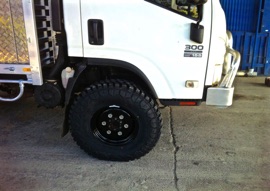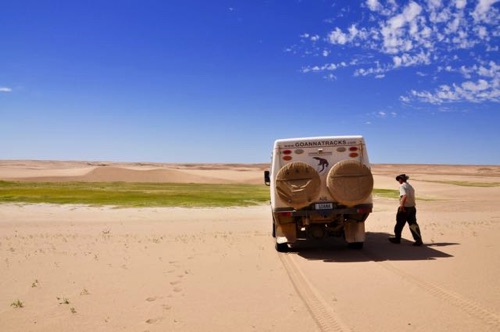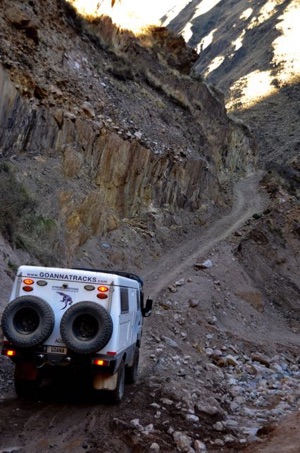
Mountain Road
4300m Andes Mts
Peru Sth America
No Road Testing
Gobi Desert
Mongolia
Testing - Both Independent and Personal
& All the Techicnal stuff
A critical part of a successful product
The story behind the rims, is a desire for a Super Single wheel to use on our personal Overland Travel vehicle.
One would have to ask why would I spend 18 months researching and then finally having the 17 x9" rims specifically made.
Simply because the other options truly did not suit the application, and there had to be a better solution !
Fellow adventurer travellers began to ask for our Super Single Wheels but before I marketed them commercially I invested in independent testing under SAE J328 by the Mechanical Testing Laboratory of ROH.
Rim Testing Under SAE J328:
This SAE is the minimum international performance standard for fatigue testing of wheels for passenger cars, light trucks, and multipurpose vehicles.
The SAE J328 test is carried out in two parts:
A Dynamic Cornering Fatigue Test of 18,000 cycles where there will be no evidence of failure, as indicated by propagation of cracks, new visible cracks penetrating through a section, or the inability of the wheel to sustain a load.
A Dynamic Radial Fatigue Test of 400,000 cycles where there will be no evidence of failure, as indicated by propagation of cracks, new visible cracks penetrating through a section, or the inability of the wheel to sustain a load.
The Load for the SAE J328 test is a massive 2.25 times the stated load capacity.
Conformance to the Australian Tyre & Rim Associations Guidelines
The following documents confirm the rims are manufactured to the tolerances of the Australian Tyre and Rim Associations guidelines for on-road use
17x9 isuzu/Fuso Model 17x9 Iveco Model
All Goannatracks rims are made with 5mm outer bands and have a 10mm face place.
To our knowledge we are the only manufacturer offering 5mm outers. No manufacturer did so globally so we invested in a rolling mill to do so. Normal LandCruiser type rims use 4mm outers and these were destroyed during early testing and did not pass the fatigue test under SAE J328.
Super Single Advantages
Changing dual wheels to super singles offers the following advantages.
• Significant improvement in off-road ability particularly in sand and mud.
• Eliminating the problem of rocks caught between the rear dual wheels
• Changing/checking tyre pressure reduced to 4 and not 6 tyres.
• Only one spare is needed
Changing the tyre size from 32” to 37” offers the following advantages.
• Improved ground clearance. ( Diff height change + 50mm )
• Improved approach, departure and ramp over angle.
• 14% lower engine RPM
An Isuzu NPS at 95KPH ( GPS Reading) is 2400RPM after fitment is 2050RPM =14.6%
A Fuso Canter at 95PKH ( GPS Reading) is 2650RPM after fitment is 2300RPM = 13.3%
• Less in cab engine noise at the same speed
• Improved fuel economy, as bigger rolling diameter.
• The torque of the vehicles is very capable to handle the larger size with ease.
• The ride is significantly improved.
On-road tyre pressure is recommended at 45/50 Psi unlike the OEM wheels at 80 Psi, or the Toyo's on 19.5 rims at 80/120Psi
The Hankook Dynapro 37x12.5R17's are flotation tyres, that bulge when deflated, giving a massive footprint for sand driving ( 20-22 Psi )
The TYRES and why 17x9's ?
Vehicle rims come in two types.
Type 1 for Cars, SUV's and Light Trucks like the Ford F series, other big American trucks, and the Military and Civilian Hummers.
These are 15", 16", 17" and 18" rims and tyre manufacturers make a vast range of tyres to suit the on and off road requirements of these vehicles.
For Fuso, Isuzu and Iveco vehicles using a 17" rim and a 37" tyre the distance between the rim and the outer diameter of the tyre, ( the side wall height, in this case 10 inches or 252mm ) offers a far better ride and a massive footprint on deflation in sand or mud.
The big plus is the availability of a 37x12.5 R17 tyres both locally and internationally.
Hankook, BFG, Micky Thompson, Yokohama, Cooper, Goodyear, Falken, and Nitto Trail all offer a 37 x 12.5 R17’s so one has a vast choice.
The load /speed rating of most of these is 124Q 1600Kg@160KPH but not more.
Hankook Dynapro MT's 124Q - 1600KG @160KPH
Type 2 rims are for Heavy Transport, these are 17.5", 19.5" and 22.5". The tyres that are manufactured for these rims are designed for extremely heavy loads and generally black top driving.
For this reason the recommended tyre operating pressures are high and in the region of 100psi or more. The side walls of such tyres are extremely strong and give almost no flex and regardless of lowering the pressure the ride is still as if your were in a concrete truck !
Using for example a 19.5" rim and say a Toyo 285/70R 19.5 M608Z. The rim diameter is 19.5" and the tyre diameter is 35.4". Hence the side wall height is only 7.95" or 200mm. With such a strong construction and high pressure there is little or no flex. This all equals a hard ride and little off-road ability.
See Below....
Comments on Super Singles available:
16 x 6.5” mounted with Michelin XZL’s 255 100R 16’s.
These are the Iveco factory fitment option for the Iveco Daily 4x4 and is also a discontinued option previously available for Fuso and Isuzu vehicles.
These are a great tyre, we used them across Australian deserts, on the Road of Bones in Siberia and for our travels Vladivostok to London.
There are a number of issues using the Michelins:
• The cost is near A$ 1000 in Australia (US$810 in the US), the second is the availability.
• They are very rare. The supply is difficult in Australia and impossible in many other overseas
countries.
• The best we attained from our two set of 4 was 35,000 and 40,000 Kms, which made running costs
extremely high.
• There is no other alternative tyre that fits a 16x6.5” rim.
• The Michelins are speed rated to 100KPH, not ideal for highway driving.
• On road noise is high and difficult to have an in-cab discussion
• Over 80KPH on the black top they heel and toe significantly, require constant rotation and with the
increase in heel and toe the noise level increases.
Tyre Height: 915mm ( 36.2 inches) Sidewall Height: 255mm
Total tyre + rim weight combination is 60Kg
19.5 x 8.25” mounted with Toyo M608Z 285/R70/19.5
These are extremely heavy duty 16ply tubeless tyres for semi trailers. As quoted from the Toyo site "The M608 is a dependable drive tyre designed for regional and urban pickup and delivery service" .
Because they have such a strong side wall, airing them down for off road use is useless. To get a reasonable footprint they must be aired down so far that one is likely to break the bead.
On road, the suggested travelling pressure (120psi) is so high that the vehicle rides like a concrete truck.
With such a strong side wall reducing to 80psi achieves little.
Tyre Height: 877mm ( 35 inches) Sidewall Height: 199mm
Total tyre + rim weight is a whopping 80Kg
Here are the suggested running pressures from the 19.5" rim supplier.
ewExternalFiles/Tyre%20psi%20for%20ATW%20Scout-1.pdf
17 x 9” Alloy Wheels
Warning: I have seen on the Australian and US market some 17x9” alloy rims fitted to the Fuso Canter and Isuzu vehicles. The face plate of these wheels is 15mm thick and does not allow the wheel nut to do up 100%. With only 60% of thread holding on the wheel, not only is this highly illegal it is extremely dangerous.
Personally I am not in favour of alloy rims for off-road use. Under hard knocks alloys crack - steel bends.
Yes they use them for off-road racing BUT they have support crews to carry spares !
17x9” Steel Wheels for Iveco
There are some new 17x9” wheels on the market but with only a 4mm outer band. In our initial development we tested a 4mm outer and the outer band failed with catastrophic consequences. This is a copy of our SAE J328 test back in 2012 with a 4mm outer band. ROH Failed SAE J328 with 4mm outer
I note these are not supplied with an SAE J328 test report.
Furthermore the off set is such that to be fitted legally one must add wheel arch flares.
GoannaTracks 17 x 9” mounted with Hankook Dynapro Mud Terrain 37x12.5 R17 I found these an excellent all round tyre/rim combination. They are great off-road, giving good positive direction and feel. Airing down for sand gives a massive foot print.
The big plus is the replacement tyre price (around A$415 in Aust, US$350 in the USA) and the availability internationally.
I now have 1000’s globally without a single issue.
Tyre Height: 934 mm ( 36.8 inches) Sidewall Height: 251mm
Total tyre + rim weight combination is 66Kg
Fitment:
Fuso & Isuzu rims have two valve holes allowing easy access to adjust tyre pressure when mounted face out (front) or reversed (rear). A normal straight fitting on the outside and a 90-degree valve stem on the inner side allows this valve stem to clear the internal front brake hub.
Removal of dual wheels and fitment of Super Singles may or may not be road legal and fitment of them is at the owner's discretion.
These rims are structurally sound, and apart from the independent load tests detailed above, I have driven over 140,00Kms across the Gobi Deserts (sand), Alaskan Ice roads (rocks), and the notorious Brazilian BR319 through the back end of the Amazon (mud), all without issues. Average tyre life has been 60,000Kms without the use of a spare. My vehicle weights an average of 5000 to 5500Kg.
For all Fuso and Isuzu vehicle fitment ideally requires a set of front wheel nuts to be used on the rear wheels. These would be available from Fuso, Isuzu or a truck wrecker. I get mine from Bretts Truck Parts
Vehicle modifications that I am aware of:
Should the springs have sagged and almost on the bump stop, then consider a spring upgrade.
I recommend Suspension Supply Australia who do a great kit at a very affordable calculation.
Call Nathan on 1800 630 411 He can also explain why not to go with parabolics.
http://www.ssa.com.au/japanese-truck-suspension.html
Fuso FG649 and earlier models
The air conditioner in front of the front left wheel may need moving or modifying.
The front left entry steps may need knocking forward as the left wheel may touch when cornering. A knock with a sledgehammer will move it forward from the standard 50mm clearance to 80mm.
The wheels will need to be straight when tilting the cab.
Iveco 55S17W
With the 37” Hankook tyres the Iveco Odometer now reads accurately.
As the 37x12.5 R17 tyre is slightly wider than the factory original, the Iveco diff lock mechanism above the spare tyre needs to be moved up on the chassis by 20 mm. Instructions
Brakes:
Some vehicles may need brake modification. I have not modified my FG84 and have found it un-necessary.
If you are used to driving a car you may feel more comfortable with a brake upgrade. The guys at BHSS
can do wonders with the brakes on Fuso, Iveco and Isuzu trucks. Talk to Rod Cooke on 07 3620 6555
Some suggest a larger vacuum tank however that does NOT improve the braking efficiency. It only
gives more volume when pumping the brakes on a long descent. In this situation you should be using
the exhaust brakes - that is what they are designed for.
Odometer/Speedometer:
With larger diameter wheels for Fuso and Isuzu vehicles you will need to adjust your speedometer/odometer.
Option 1: Use a Hummingbird Speedo Calibrator HMSC8000A. Available from E-Bay for $85.00
Fitting instructions pdf When you order you can ask the supplier to pre set at 114% ,
alternatively turn the small adjustment screw 1 1/2 turns clockwise, then fine calibrate against
your GPS.
Option 2: Use a step up box by Flexible Drive Agencies. www.flexibledrive.com.au
Part number WW-NS-25838 1.284:1 ratio $145.00
Option 3: A simpler alternative is to drive by your GPS speed.
Tyre Pressure:
How a tyre performes, the vehicle's ride and tyre longevity all depends on the pressure.
You will need to know the actual axle weight ( curb weight) as measured on the front and rear axle. This is NOT the axle load as per the vehicle specifications but the actual load in your vehicles normal configeration.
Use this Rim and Tyre Pressure Calculator and fill in the yellow spaces and it self calculates a guide for tyre pressures for on-road, off road and sandy conditions.
I am more than happy to answer any questions by emailing Goannatracks@gmail.com or phone 0418 154 042
The Fuso/Isuzu rim has been tested at 1850Kg x 2.25 = 4,163Kg and ran for 954,000 cycles which is twice the requirement, before testing was stopped. SAE J328 Isuzu/Fuso Wheel Report.
The Fuso / Isuzu axle loads are as follows:
Isuzu NPS 250/300 Post 2010 - Front 2900 Rear 5600 Kg
Isuzu NPS 250/300 Pre 2010 - Front 2600 Rear 4000 Kg
Fuso FGB71 - Front 2800 Rear 5760 Kg
Fuso FG84 - Front 2600 Rear 4300 Kg
Thus at 4100Kg per wheel, it is well within the axle load requirements.
The above tests were completed with a Hankook Dynapro MT 37x12.5 R17-129Q ( 1850Kg @160KPH)
Since January 2013 this tyre is no longer available.
The highest rated on-road commercially available tyre is currently the 124Q's ( 124 = 1650KG and Q = 160KPH) from Hankook and other manufacturers.
The Iveco rim has been tested at 1700Kg x 2.25 = 3,825Kg and ran for 1.8 Million cycles.
The Iveco Front/Rear axle carrying capacity is 2450/3700 Kg, thus the wheel can support more than TWICE the rear axle load.
This is my preferred option. I am on my 3rd set and without the use of spares the average usage has been 60,000Kms. The terrain covered included high speed highway driving, many gravel roads, muddy tracks, and sandy cross country driving, in all 146,000Kms.
These tyres also won the American Tyre Shootout: See: 4Wheeler Tyre Test
I have also had them tested under SAE J328 at 1700Kg x 2.25 = 3,825Kg
Our fully loaded vehicle averages between 5000 and 5500Kg and I run the Hankooks at 46psi on road, dirt tracks 36 psi, sand tracks 30 psi and very soft sand down to 20psi
On-road, the noise level is much less than the other options yet they are great off-road, giving good positive direction and feel.
Airing down for sand driving gives a massive foot print.
Tyre Height is 36.8", Width 12.5" Total tyre + rim weight combination is 66Kg
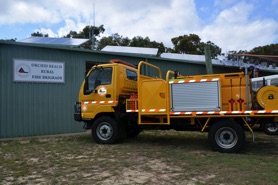
Originally fitted with 19.5s and with 65psi for the rear and 47Psi in the front it is no wonder the Frazer Island Rural Fire Brigade had difficulties driving in the sand.

Now fitted with the 17x9's and 37" Hankook Tyres they can drive sand hills like never before !
The guys are exceptionally happy.
Testimonial Orchid Beach Rural Fire Brigade
Fitment to the rear axle.
1. Remove the outer nuts, then the first dual wheel.
2. Remove the cover stud ( with the square end), then
the inner wheel.
3. What remains are the rear wheel studs.
4. These are the same size (but not necessarily the same
part number) as the front wheel studs.
5. You will need a set front wheel nuts to mount the rear
wheels.
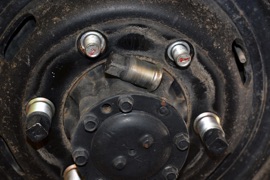
Fuso FG84
The front left entry steps may need knocking forward as the left wheel may touch when cornering. A knock with a sledgehammer will move it forward from the standard 50mm clearance to 80mm.
The wheel flare will either need removing, cutting back at the front or add a wider flair. Rubber ones are available from auto shops. See accessories for my new wheel flair.
When tilting the cab, the wheels will need to be turned full lock left if you have standard springs or straight with after market springs.
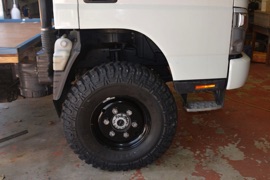
Isuzu NPS
The front steps either need modifying or removing the bottom step all together.
The front mud flaps will need holding back or modifying.
The front rear guards can be moved outwards about 30mm as there are extra holes in the guard to allow for this.
When tilting the cab turn the wheels to the left about half way.
Earlier model NPS may need modification to the air conditioner condenser brackets in front of the LHS wheel.
